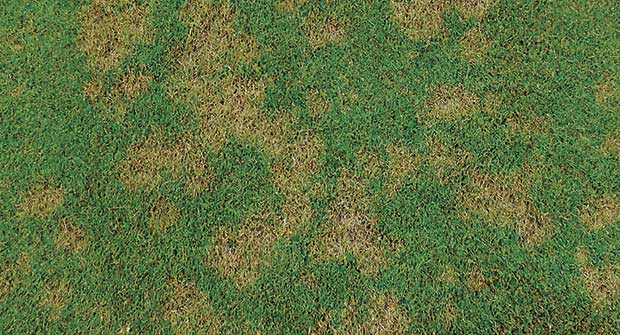Dollar spot is a fungus that can strike cool-season and warm-season turf. Here to share the best cultural controls and techniques to prevent dollar spot is Aaron Hathaway, technical services manager for Nufarm; Brian Aynardi, Ph.D., Northeast research scientist for PBI-Gordon Corp.; and Matt Giese, M.S., technical services manager for Syngenta.
Dollar spot prevention fungicide application tips:
BA: Lawn care operators (LCOs) should monitor weather conditions when warmer day and nighttime temperatures with high relative humidity are prevalent. Also, utilization of the Smith-Kerns dollar spot model would be a valuable tool for LCOs in determining proper application timing.
MG: Proper timing for a preventive application means applying the fungicide prior to disease development and long before actual symptoms are observed.
AH: LCOs can make these applications when average temperatures are consistently at or above 55 degrees F. A turf manager can then choose to make subsequent applications on a scheduled basis (e.g., every four weeks) or scout and apply again when the disease is observed.
BA: Making timely fungicide applications when environmental conditions are conducive for disease development reduces unessential fungicide applications.
MG: Preventive applications also have the benefit of greater effectiveness since they work when the infestation is small and not in its advanced stages that typically require higher fungicide rates to achieve the same level of disease control.
AH: LCOs should use preventive fungicide applications for dollar spot control on properties where any disease or blemish cannot be tolerated. Preventive fungicide applications may be warranted for LCOs who manage many accounts as well.
Curative fungicide application tips:
BA: Curative applications for dollar spot won’t make the symptoms go away overnight. The fungicide needs time to stop the fungus from infecting the host plant and allow the plant time to recover.
MG: Combination fungicides with azoxystrobin and propiconazole provide dollar spot control as well as protection from multiple other diseases.
AH: Dollar spot can be especially damaging in the fall when days are warm and nights are cooler, which result in heavy dew that lingers into the morning. In the fall, the angle of the sun becomes more severe and doesn’t dry the leaves as quickly. Scout for dollar spot on fine fescue, bluegrass and, to a lesser degree, in cool-season lawns such as ryegrass.
BA: Active ingredient isofetamid is an excellent fungicide labeled for residential and commercial turf for control of dollar spot.
MG: Having a disease control plan before the season will provide some structure initially, but your plan should be flexible to allow for inevitable adjustments as the season progresses.
AH: Fungicides do not last forever in or on turfgrass plants as they break down and are mowed off continually and must be reapplied to reduce
the pathogen.
Cultural control tips:
BA: Cultural control options should be considered year-round and implemented well before dollar spot is observed, or environmental conditions become conducive for disease to develop.
MG: Irrigating to turfgrass need and timing irrigation cycles to occur before sunrise or in the early afternoon will encourage dry foliage and reduce disease occurrence.
AH: LCOs should always be paying attention to the health of the turf stand they are managing. LCOs should look for and address stresses on each lawn, whether it is dull mower blades, a broken irrigation head or grub damage.
BA: Cultural controls for reducing dollar spot severity include increasing nitrogen fertility, improving airflow by pruning trees and shrubs, allowing for more sunlight to reduce free leaf moisture and using resistant cultivars.
MG: Proper mowing height and alleviating soil compaction are important factors for helping turfgrass withstand stresses. Communicating this information to homeowners is an important step.
AH: Dollar spot is always more severe in nitrogen-deficient lawns. Providing adequate nitrogen helps the turf grow out of symptoms and maintain growth even when lighter infections occur.


